Luxury Travel Review

What we liked about The Holy Donut in Portland, Maine
By Elena del Valle
Photos by Gary Cox

The front entrance to the Holy Donut
As soon as we heard about The Holy Donut (194 Park Ave and 7 Exchange Street, Portland, Maine, +1 207 874-7774, www.theholydonut.com, holydonutorders@gmail.com) from a local foodie we were intrigued. Established by co-owners Leigh Kellis and her father Allan Kellis the popular eatery in the heart of Portland, Maine made potato doughnuts from scratch.

The board with the daily specials
The busy shop we visited on Exchange Street sold a variety of donuts made the old fashioned way from hand-cut Maine ingredients and potatoes. They rotated 16 flavors daily. They included Maine Potato with Pure Vanilla Glaze, Maple, Pomegranate, Fresh Lemon (hand squeezed and lemon zest), Real Mojito (fresh mint and lime zest), Allen’s Coffee Brandy (made with a Maine liquor), and Toasted Coconut with Coconut Milk Glaze.

Our favorite donut and a hot chocolate
There was also Dark Chocolate with Pure Vanilla Glaze, Sea Salt, Cinnamon Sugar, and Toasted Coconut and Coconut Milk Glaze (our favorite from the few we sampled). There were also Sweet Potato donuts made with roasted sweet potatoes and Maine potatoes, Vegan, Gluten Free, Filled, and Bacon-Cheddar (another favorite). We can’t wait to go back to Portland to indulge in our favorites and sample new flavors.
A visit to the Whitney Museum of American Art in NYC
Photos by Aaron Lubarksy

An advertisement for the Whitney on the stairs of the New York City subway
Earlier this year, the Whitney Museum of American Art opened its new location in the Manhattan Meatpacking District. Our contributors visited the museum and liked the building, which they considered a work of art in itself, and its contemporary art collection.

A sculpture on one of the Whitney’s terraces
They saw famous paintings by contemporary artists Edward Hopper, Willem De Kooning, Barbara Kruger, and Jean-Michel Basquiat. They also appreciated the surrounding neighborhood full of markets, restaurants and views, and took advantage of their visit to explore the area near the building.
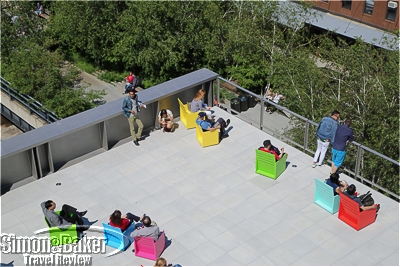
A site-specific exhibit by Mary Heilmann on the largest outdoor gallery at the museum
Spa indulgence in Nevis
Article and photos by Elena del Valle
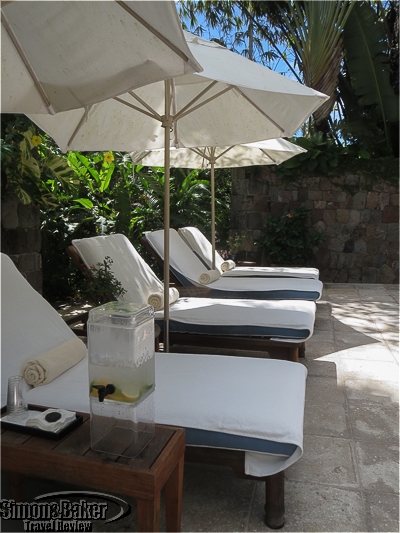
One of several outdoor areas at the Four Seasons Spa
Heading to the tiny island of Nevis in the West Indies I was unsure what to expect in the way of spas. I was pleased to discover several options. I tried three facilities, the spa at the island’s largest and best known resort, a family run spa and salon in a residential area, and a small salon in the main town of Charlestown, both locally owned.

The Compassionate Touch Spa and Salon was in a residential area

Valencia Griffin, co-owner and therapist, Compassionate Touch Spa and Salon
The spotlessly clean 1,848 square foot Compassionate Touch Spa (Nisbet Estate, Saint James Parish, Nevis, +1 869 469 9748, +1 718 594 1712,wwwcompassionatetouchspa.com, tdgriff@sisterisles.kn) in a tranquil village on the north side of the island could accommodate up to five guests at a time. Because we arrived late my Nevis Therapeutic Massage was cut short, although there was time for an owner led walk through the facility before my treatment. Established in 2001, the spa had been renovated in 2007. In addition to owners David and Valencia Griffin there were three staff. Ms. Griffin trained at the Nothern Institute of Massage of the Essex School of Beauty. There was a wet treatment room, a pedicure room, three massage or facial rooms, one manicure room and a waiting area. There were lockers, robes and slippers.

Tip Toes Nail Salon was in the main town of Nevis

Calette James, owner, Tip Toes Nail Salon
I stopped in Charlestown for a massage by Calette James at the Tip Toes Nail Spa and Beauty Haven (Hunkins Plaza, Charlestown, Nevis, +869 762 4500, tiptoesnailsspa869@gmail.com), a facility near the main road. It had a reception area and a treatment room. Guests had access to a locked and clean shared restroom behind the salon.

My smoothie and a bento box with fresh fish at The Spa at Four Seasons Resort Nevis tasted as good as it looked
The Spa at Four Seasons Resort Nevis (P.O. Box 565, Pinney’s Beach, Charlestown, +869 469-1111, http://www.fourseasons.com/nevis/spa/spa_overview/, spaConcierge.nev@fourseasons.com) was located within the resort, which in turn was on Pinney’s Beach. Open to hotel guests and the public the spa was popular, though not crowded, while I was there in the low season. A staff of 23 worked at the 12,000 square foot establishment with 12 treatment rooms, six outdoor freestanding cottages and six indoor treatment rooms.

The heated jacuzzi at The Four Seasons Spa was popular

The manager at the Four Seasons Spa
During several hours of spa indulgence I spent time in the outdoor volcanic stone whirlpool bath, cold plunge sala style pool with viewing deck of Nevis Peak (Mount Nevis) and a golf course, had a Spa Cuisine Bento Box Lunch made fresh at the resort, and received a Nevisian Massage (no longer available) in an outdoor cottage. The spa manager, Bernadette Gonnet, was in the reception area when I arrived and made several helpful suggestions. The staff members I met were friendly and the facilities quiet and pleasant. It was one of the highlights of my Nevis trip.
Bloomington trail offered pedestrians, cyclists space, greenery amid central urban setting
Article and photos by Elena del Valle

Signs along the trail described its history
During a recent stay in Bloomington, Indiana I discovered the B-Line Trail, a 12 food wide asphalt, multi-use 3.1 mile pedestrian and cyclist pathway, when I asked about jogging near my centrally located hotel. Meetings and activities kept me busy the majority of the days and into the early evenings. Taking advantage of the little free time I had at my disposal in the early mornings I set out to explore as much of the trail as I could.

One of five different exercise devices in three fitness stations on the trail, south of First street
It ran from the east side of Adams Street, through downtown, past the switchyard property, to the north side of Country Club Drive. It had well marked ground level street crossings at the intersections. Many of the cars stopped or slowed down when they saw pedestrians at the crosswalks. There were pedestrian bridges over Third Street and Grimes Lane. There were paved plaza areas next to City Hall, at the WonderLab Museum, behind the Convention Center, and at Seminary Square shopping center. There were exercise stations, benches and public art scattered along the trail, especially near the downtown section.

There were signs highlighting spots along the trail
Perhaps because of the summer break it was a bit lonely jogging in the predawn hours. Some of the graffiti peppered under bridges and abandoned buildings spooked me at first. As the sun rose, there were more people cycling, walking, jogging and walking their dogs. Some took advantage of the two foot wide gravel shoulders on each side.

A view down the trail in the early morning from one of the bridges
Every so often there were garbage bins, bags for dog poop, and new looking LED street lamps on the trail. Even in the area furthest from downtown Bloomington it was never dark for very far on the path. Along the green sections, bird song mixed with the background buzz of early morning traffic and the mechanical sounds of nearby construction. Every once in a while I spotted birds. One mornings, I saw a rabbit next to the trail.

One of many signs that marked the trail path
Signs described the project, which was accomplished by the city through land acquisition for the three-mile former rail corridor (most of the costs, 80 percent, were funded by federal grant dollars). Other signs highlighted historical landmarks and public art. There were eight art pieces on the trail. I noticed a weathered steel sculpture titled “Dancing Spirit” near downtown. Some of the buildings I passed had murals made possible by a city grant.
The city had bought 28 acres of land adjacent to the southernmost section of 1.25 miles from Grimes to Countryclub in the abandoned former McDoel Railroad Switchyard. Administrators planned an addition to be named Switchyard Park and meant to feature outdoor performing arts venues, active recreational sport courts, walking trails, skatepark, splash pad, playground, and large multi-use facility.
Every morning I looked forward to my walks and jogs on the trail. They allowed me to exercise and discover a little of the city and its history, including some brush and greenery. On the path, I came across a convenient grocery store and a small cafe where I bought nutritious and tasty smoothies. The next time I visit Bloomington, I will seek accommodations near the B-line Trail. Perhaps by then the Swityard Park project will be complete.
A tiny slice of Tibet in Bloomington, Indiana
Article and photos by Elena del Valle

One of two signs at the entrance to the Kumbum Chantse Ling Monastery in Bloomington, Indiana
My favorite attraction during a three-day visit to Bloomington, Indiana was the Tibetan Mongolian Buddhist Cultural Center (TMBCC). As soon as we arrived at the brightly painted Tibetan style entrance gate I was transported back to Asia. A scant five miles from the city center the 108-acre property housed Chamtse Ling Temple, Cultural Building, two traditional Tibetan stupas, four retreat cottages, a Teaching Pavilion and two private residences. In the Cultural Building, where I and my tour group spent most of our time, there was a library, a kitchen, community space and an amply stocked gift shop.

The stupa at the Tibetan Mongolian Buddhist Cultural Center
Founded in 1979, the Center’s three main goals were to foster and preserve Tibetan and Mongolian cultures, provide Buddhist teachings to the community, and promote interfaith peace and harmony. As a monastery it had a permanent small monk population that lived onsite year round. The center and temple were open to the public.

A meeting room at the Tibetan Mongolian Buddhist Cultural Center
We began by visiting the Cultural Building’s Main Hall, where we had lunch in an informal area adjoining the kitchen. Following the simple self serve meal of delicious noodle soup, corn on the cob, and lettuce with a memorable dressing (although there was hardly any lettuce by the time I had a chance to serve myself, the dressing was my favorite part), we moved to an adjacent meeting room.
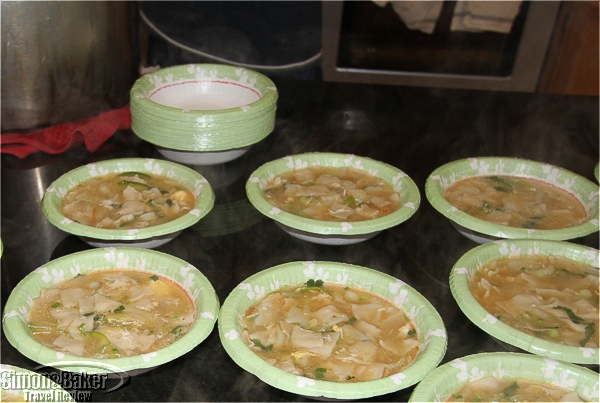
We had self serve noodle soup, corn on the cob, and lettuce salad for lunch
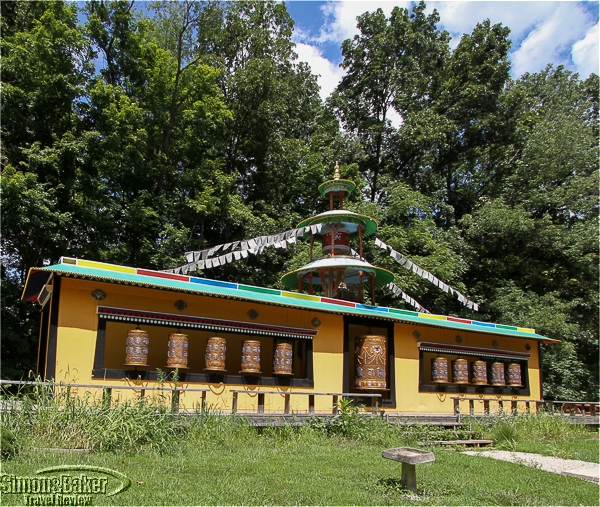
Wheels at the Tibetan Mongolian Buddhist Cultural Center

Tibetan monks from the Labrang Tashi Kyil and Tibetan Mongolian Buddhist Cultural Center, a refugee monastery in Dehra Dun, India
Seven Tibetan monks from the Labrang Tashi Kyil and Tibetan Mongolian Buddhist Cultural Center, a refugee monastery in Dehra Dun, India, were visiting the Center. One by one they recited their life stories. Most of them spoke in their native tongue while one of their colleagues translated in thickly accented English. A Center volunteer explained they were touring the United States to share a message of wisdom, and searching donations for their monastery, where 50 young monks from the Tibetan-Himalayan region were awaiting education and receiving healthcare.
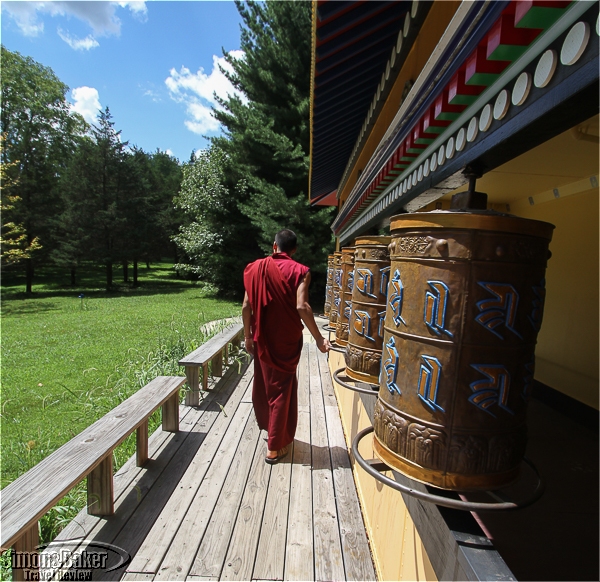
A monk walked by the wheels at the Tibetan Mongolian Buddhist Cultural Center

Tibetan style sand artwork in the Dalai Lama’s private quarters
From there we walked a short distance over a narrow paved path and green grass to the wheels and stupa en route to the Kumbum Chamtse Ling Monastery set aside for classes, meditation instruction and retreats. The upper floor, closed to the public, was home to the private quarters of the Dalai Lama, the religious leader of Tibetans.
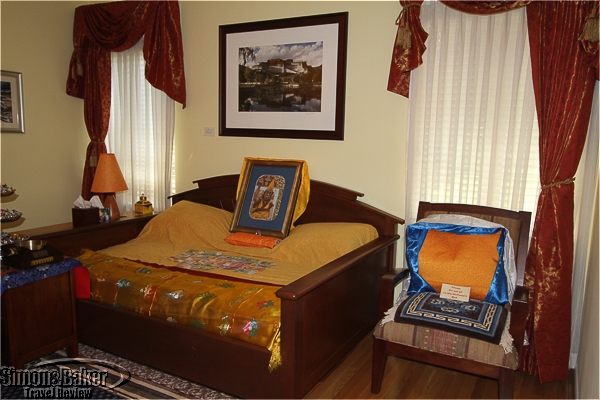
The Dalai Lama’s bedroom
The 501 (C) 3 nonprofit organization’s main sources of funding were programs, facility rentals, donations and guest lodging. I would recommend a stop at the Tibetan Mongolian Buddhist Cultural Center (3655 Snoddy Road, Bloomington, Indiana, 47408, United States, +1 812 336 6807, TMBCC.org, tmbcc.kc@gmail.com) to friends wishing to visit a Tibetan Buddhist temple in the United States. I enjoyed lunch, and the three-hour afternoon group tour, and would welcome the opportunity of a return independent visit with quiet time to further explore the center and its grounds.
Why we treasured private tour at Miami wildlife sanctuary
By Elena del Valle and photos by Gary Cox
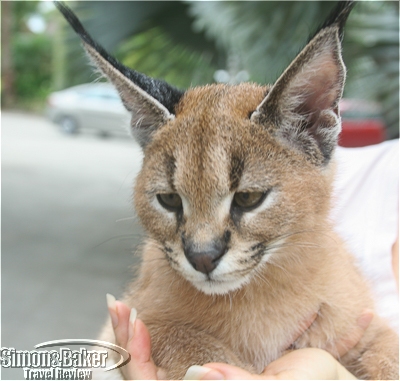
Freya, a caracal lynx
As I stood near a lion themed water fountain in a subtropical garden at the Zoological Wildlife Foundation in the southwestern suburbs of Miami, Florida holding Freya, a relaxed caracal lynx, an African khaki colored wild cat with pointy ears, I marveled and took a mental snap shot of the special moment. Never in the many safari drives and walks I have been fortunate enough to enjoy over the years had I come close to the elusive bush animal. Freya allowed me to pet its head and back. I was surprised at how soft the fur felt and how comfortable Freya was settled in my arms.

Vadim, a rare amur leopard
Sure, the caracal’s attention span was fleeting. It turned left toward a group of visitors near the monkey cages and right as the sounds of nearby construction drew its attention. Yet it was calm, allowing me to savor the experience while my partner struggled to photograph it because while its body remained immobile its head swiveled around constantly. It was curious and distracted, making it difficult to capture even a single clear image.

Mario Trabaue holding Onyx, a restless black jaguar
Next, we had a chance to hold Onyx, a young black jaguar. Despite the clouded midday sky we could see the muted rosettes on his black coat. They were stunning. Freya seemed downright angelic in comparison to the gorgeous jaguar who would not be still, not even in the arms of its expert handler. After a few moments of intense and futile wrangling I passed Onyx back to him. He had little more luck than I did. Eventually it was my travel partner’s turn to hold the cat. When for an instant Onyx calmed down I lifted the camera to take photos until my partner yelped. The reason the cat had seemed less agitated was because it was defecating and the excrement landed on his arm. The incident did nothing to dampen our enthusiasm. He cleaned his arm as best as he could with the chilled iced tea bottle we had at hand while we watched Onyx leave in the company of its owners, Maria C. Tabraue and Mario Trabaue, who had come to greet us during our Zoological Wildlife Foundation Private Tour with a primate and feline interaction session.

Sarabi, a playful tiger cub
Stephen Gregorio, our friendly guide and the Foundation’s zookeeper, had Vadim, a rare amur leopard, on a leash a few feet away from us. They had been standing there during our interaction with Onyx. Vadim too returned to his enclosure shortly after Onyx. In the interim, we awaited the arrival of Sarabi, an adorable tiger cub. We could not get enough of him. He acted like the aloof celebrity he was, gently biting his handler’s pants, pouncing on plants, and stalking invisible prey. We also spent quality time with Amorette, a capuchin monkey, and after her Chung, a gibbon. Curious and playful she arrived with a stuffed companion and was relatively calm in my arms. Chung, on the other hand, wouldn’t hold still for a moment, and was desperate to flee and explore on his own.

Stephen Gregorio, zookeeper at the Foundation, and Amorette, a capuchin monkey
Many of the non human inhabitants of the Foundation were born there (50 percent of the babies had been born and remained at the facility) or transferred from Zoological Association of America accredited facilities. Some were rescues from people who could no longer house them while others had been seized from owners without permits or wildlife violators. Still others had been abandoned, injured or brought for rehabilitation. Whenever possible the Foundation released rehabilitated animals, a spokesperson explained.

Chung, a gibbon, wanted to explore
The five-acre facility welcomed approximately 20,000 visitors per year. While we awaited our tour guide in the check-in arrival area we heard several foreign languages. It was no surprise since slightly more than half of the visitors were from out of the state or the country. I imagined the intimate wildlife experience drew many of the tourists from near, like us, and far away. According to a 2014 article by Sharon Guynup in NationalGeographic.com only 3,000 tigers may remain in the wild.
According to WildLifeConservationSociety.com only 25 to 40 amur leopards remain in the wild. During our visit to the Foundation we saw a tiger and an amur leopard. They were clean and appeared to be well looked after by the staff. While my preference remains to see wildlife in its natural habitat, in those cases where the animals may no longer survive and thrive in the wild a captive environment may be the only alternative. The Foundation provided a home for its animal residents and an opportunity for visitors to support the upkeep of the animals and at the same time visit them. It was a memorable experience worth repeating.







